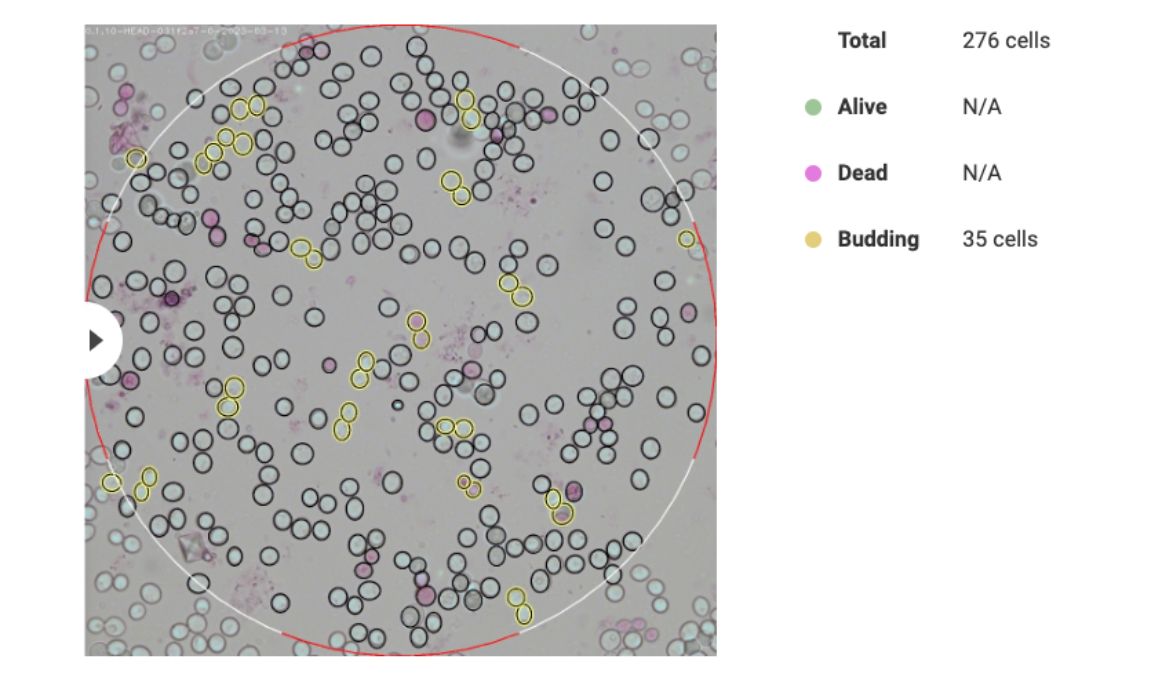Yeast Cell Concentration
So now you know what your yeast cell concentration is. How can you use this data?
Yeast cell concentration, typically expressed in millions of cells per milliliter, is one of the most important parameters for a brewer.

First off, knowing your yeast cell concentration is important during the pitching process.
In the well-known book Yeast: The Practical Guide to Beer Fermentation, the authors recommend 0.75 million cells / ml / degree Plato for ales and 1.5 million cells / ml / degree Plato for lagers. However, these numbers can vary depending on several factors, most notably the yeast strain, but also on what you’re looking for in terms of the flavor profile. And, of course, you can also step outside the norm while experimenting.
However, if you’re aiming at consistency, as it’s almost always the case, you must know exactly how much yeast you’re pitching in each batch of a certain beer you’re brewing and stay true to that number for all future batches. And in order to inoculate at a correct rate, you must measure accurately two parameters: yeast cell concentration and yeast viability.
Besides the consistency issue, underpitching can result in longer fermentations, with a high economic impact, while overpitching can lead to loss of bitterness, filtration issues, and a high risk of yeast autolysis (the rupturing of the yeast cell and the leaking of undesirable substances in the beer, ultimately leading to off-flavors).
Additionally…
Underpitching can:
- Increase the levels of diacetyl, esters, and volatile sulfur compounds;
- Cause higher final gravities;
- Intensify the hoppiness of the beer;
- Lead to stuck fermentations.
Overpitching, on the other hand, can:
- Cause the beer to ferment too fast;
- Reduce ester production;
- Lead to low viability yeast crops;
- Cause a loss of bitterness;
- Affect the mouthfeel of the beer.
So putting a protocol in place, with a consistent inoculation for each batch of each type of beer you’re producing, is essential for successful fermentation and product consistency. So use your Oculyze yeast cell concentration (and viability) results to do exactly that. Moreover, you can use the Pitch Rate Calculator available in the Oculyze app to find out the exact amount of yeast you need to pitch without having to do the calculations yourself, manually.
Another important thing you can do with this data, also as part of the pitching process, is to verify the yeast manufacturers’ claims. Unfortunately, there are countless accounts of brewers ending up with a lower concentration yeast, so basically less yeast, than what’s specified on the packaging. Either that or the range is so wide, such as “we guarantee between 60 and 120 billion cells per package” that there is simply no way to control exactly how much yeast you’re pitching. This can have disastrous effects, from brewing a poor quality beer to stuck fermentation and up to having to ditch an entire batch. Not to mention that if for one batch you pitch a yeast that’s at the lower end of the range (so a package that contains 60 billion cells) and for the next one you end up with a package that actually contains the number of cells at the higher end (so 120 billion), this means that you’re basically pitching twice the amount of yeast for the same type of beer, in which case there’s no way you can obtain product consistency. So use the yeast cell concentration results from your Oculyze Better Brewing App to check the manufacturers’ claims and also to make sure you’ve chosen the best yeast supplier.
Lastly, but at the very least equally important, being able to calculate the yeast cell concentration allows you to efficiently harvest and repitch your yeast. Depending on the yeast strain and several other factors, such as the harvesting method and timing and the storage conditions, yeast can last for up to 5-8 generations of repitching, and oftentimes even more, so you can save tens and up to hundreds of thousands of dollars annually on yeast.
Simply harvest your yeast (download this comprehensive Guide on How to Harvest and Repitch Yeast), do a yeast cell concentration & viability analysis, and repitch the proper quantity of yeast into your next batch. This ensures product consistency and you may be surprised to discover that repitched yeast often performs even better on the second or third pitch when it comes to fermentation times and flavor compounds.
Not our customer yet?
Join the hundreds of brewers from all around the world using the Smartest Automated Yeast Cell Counter!
Request a Free Demo Account today and experience firsthand how Oculyze can take your brewery to the next level!